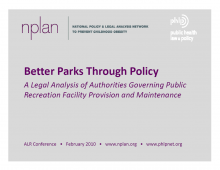We are pleased to announce an exciting new alliance between Active Living Research and GP RED to co-host and coordinate...
Better Parks Through Policy: A Legal Analysis of Authorities Governing Public Recreation Facility Provision and Maintenance

Presentation at the 2010 Active Living Research Annual Conference
Background:
The American Academy of Pediatrics recently called for governments to “create and maintain playgrounds, parks, and green spaces” and emphasized the need to provide these resources to low-income communities. Although the literature has not established a conclusive link between the presence of parks and physical activity, the Academy noted that parks provide communities with crucial opportunities for physical activity.
Research indicates that there may be differences in the presence and quality of physical activity resources between low-socioeconomic status (SES) and high-SES communities, as well as between communities of color and white communities. These findings are of concern because African-American and Hispanic populations have the highest rates of obesity. To advocate effectively for improved recreation infrastructure, public health advocates and policymakers must understand the legal and policy landscape in which public recreation decisions are made.
Objectives:
This legal research project had two objectives:
1) To identify the laws and governmental bodies that affect public recreation in communities.
2) To make the legal landscape in which public recreation decisions are made accessible to non-lawyers.
The research will be used to provide legal technical assistance to communities that want to increase physical activity opportunities through parks.
Methods:
Part I of the project provides an overview of the levels of government involved in park establishment, funding, and maintenance decisions. We reviewed federal, state, and local laws to determine each jurisdiction in this area and how these layers of government overlap (or not). In Part II of the project, we selected case studies, including Oakland, CA; Jackson, MS; and Cleveland, OH, to illustrate how these overlapping layers of legal authority function “in real life.” For each city, we performed a two-step analysis: (1) we researched current practices - which agencies and levels of park administration, and (2) we researched what could be - what state law requires and permits regarding park administration. By reviewing how parks and recreation are administered in a variety of locales, we can see how the law on the books appears when put into action. The sites selected for case studies represent different regions of the United States, have racially and ethnically diverse populations, have diverse parks system reputations, and are in states that have Robert Wood Johnson Foundation-funded childhood obesity prevention projects.
Results:
Preliminary research indicates that there are many layers of government that may be involved in public recreation in any given area. Advocates may find navigating these layers challenging because it is not always clear which agency they need to approach. This study will help advocates become more familiar with the legal landscape of overlapping jurisdictions and “ask the right questions” about who is in charge of different parks and decision-making processes in their local areas. For example, around Oakland, a park might be administered by the city, the county, the regional parks district, or in some cases, the federal government. When advocates know how to identify the proper body to petition for change, they will be able to focus their efforts effectively.
In addition, it appears that some localities may not be taking advantage of all the parks and recreation options that their state law provides, in particular special districts for parks. Further research is needed to determine whether special districts are an effective method for increasing park opportunities, and the extent to which localities do or do not take advantage of the authority to create such districts.
There are other policy implications to this work. For example, trail advocates may need to work with multiple jurisdictions to develop a regional recreational trail. This work will help advocates understand who should be at the planning table. This research will also help community members advocating for equitable distribution of safe parks. It will help them understand the context of park development and maintenance and identify ways to ensure community representation in key decision-making processes.
Conclusions:
Obesity is a public health challenge that requires policies that help people lead healthier lives in their communities. Physical activity is considered to be a basic component of good health, yet not all communities have access to safe, pleasant spaces for physical activity. By collaborating with planners, parks officials, and other policymakers, public health advocates and private individuals can ensure equal access to parks and recreation facilities and ultimately improve the health of underserved communities. However, they need to know with which agencies to work. This primer will provide advocates with an overview of the law governing parks and recreation and help them identify policy levers that will create more physical activity opportunities for their communities.
Support:
This project was supported by a grant from the Robert Wood Johnson Foundation. The research was conducted at the Chief Justice Earl Warren Institute on Race, Ethnicity, and Diversity with input from the National Policy and Legal Analysis Network to Prevent Childhood Obesity.
STAY UP TO DATE
RECENTLY ADDED TOOLS & RESOURCES
MOVE! A BLOG ABOUT ACTIVE LIVING
The "Active Living Conference" aims to break down research and practice silos and...







